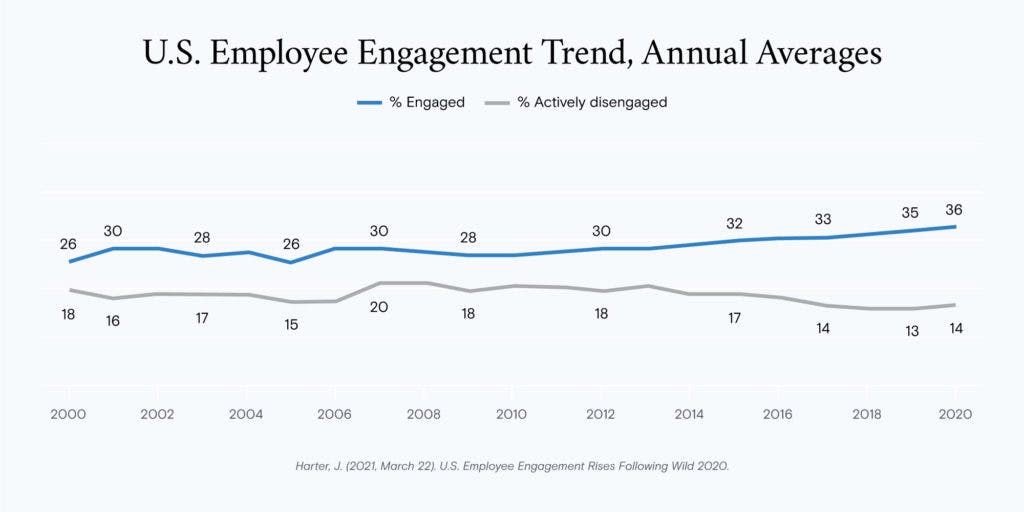This is part of our blog series on workforce education statistics that you need to know to develop and execute learning programs that build a resilient workforce, prepared for the challenges of today and tomorrow.
Companies with highly engaged employees have a competitive advantage. Engaged employees not only feel more connected to their organizations, they also help businesses thrive in terms of productivity, profit, innovation and growth.
In the past decade, employee engagement has been steadily rising. Then the global pandemic hit. The disruption of 2020 resulted in unprecedented fluctuations in the workplace, including substantial engagement drops. Fortunately, these declines were short-lived and employee engagement in 2020 finished slightly above 2019, with 2021 off to an even stronger start at 39%.

This is all good news, but there’s an opportunity to harness the potential of employee engagement even more. Many factors contribute to employee engagement — top among these are training and development. In fact, facilitating career growth is one of the top employee engagement trends in 2021, and according to Deloitte, “Learning opportunities are among the largest drivers of employee engagement and strong workplace culture – they are part of the entire employee value proposition, not merely a way to build skills.”
Employee engagement statistics
Looking at the data, it’s clear that there’s significant ROI for organizations that focus on employee engagement. Below are 10 employee engagement statistics that provide an overview of this dynamic landscape.
- Employee engagement has a very real impact on organizational success. Companies with highly engaged workforces are 24% more profitable. (Gallup)
- Disengaged employees cost organizations an estimated $450-550 billion each year. (The Engagement Institute)
- 80% of employees said learning and development opportunities would help them feel more engaged on the job. (Udemy)
- 35% of L&D professionals are looking for new ways to increase learner engagement. This was among the top 3 priorities in L&D for 2020. (LinkedIn)
- Engaged employees are 44% more productive than workers who merely feel satisfied and an employee who feels engaged and inspired is 125% more productive than the unsatisfied staffer. (Bain & Company)
- Millennials’ engagement is up to 75% in 2021, a huge jump from 35% in 2019. Key variables affecting engagement — helping them feel well-prepared, remote work and keeping them informed about what’s going on in the organization. (Gallup)
- 2 out of 3 employers say that maintaining employee morale during the pandemic has been a challenge, particularly for companies that have 500 employees or more. (Society for Human Resource Management)
- 47% of higher educated workers said a limited career path could get them to leave for a better opportunity. (Randstad)
- 94% of employees would stay in their current role longer if the company invested in their professional development. (LinkedIn)
- Companies that take an experiential approach to employee engagement are shown to have 4x the profit and 2x the revenue as other companies. (HBR)
Employee engagement and workforce education are a powerful combination. Offering employees education opportunities equips them with essential skills, and research shows that workforce education is also a key driver in building a truly engaged and future-ready workforce that drives company growth.
Interested in learning more about how to boost employee engagement through skill-building? Download this HR leader's guide to rapid upskilling and reskilling for practical tips.

